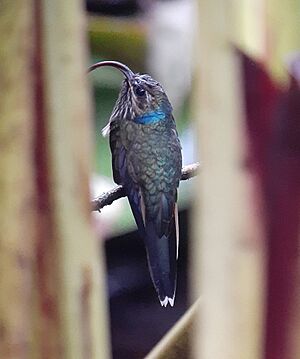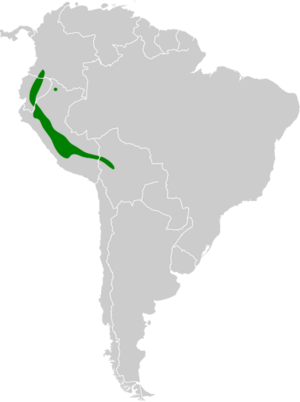Buff-tailed sicklebill facts for kids
Quick facts for kids Buff-tailed sicklebill |
|
|---|---|
 |
|
| Conservation status | |
| Scientific classification | |
| Genus: |
Eutoxeres
|
| Species: |
condamini
|
 |
|
| Synonyms | |
|
Trochilus condamini Bourcier, 1851 |
|
The buff-tailed sicklebill (Eutoxeres condamini) is a special type of hummingbird. It is known for its unique curved bill and buff-colored tail feathers. You can find this bird in the lower Andes mountains. It also lives in the western Amazon rainforest lowlands. Its home stretches from southern Colombia and northern Ecuador all the way to Peru and Bolivia.
Contents
Meet the Buff-Tailed Sicklebill: What It Looks Like
This hummingbird is quite large for its kind. It measures about 5 to 6 inches (13 to 15 cm) long. It weighs around 0.28 to 0.44 ounces (8 to 12.5 grams). Male and female buff-tailed sicklebills look almost the same. The only real difference is their size. Females are usually about 20% smaller than males.
Feathers and Colors
The top part of the bird's body is a dull, shiny greenish color. Its belly is whitish with many dark streaks. There is a light blue patch on the side of its neck. The tips of its tail feathers are white. It also has a bare stripe on top of its head, but this is usually hidden.
The most noticeable parts of this bird are its bill and tail. Its bill is strongly curved, like a sickle. The outer three tail feathers on each side are a deep buff color. This color is easiest to see from below.
Young Birds
Young buff-tailed sicklebills look a bit different. Their wing feathers have light tips. They have very little blue on their neck. They also do not have the bare stripe on their head. Baby birds, called Hatchlings, have black skin and grey fuzzy down.
Different Types of Buff-Tailed Sicklebills
There are two main types, or subspecies, of the buff-tailed sicklebill. They are quite similar and often mix together. This happens a lot in northern Peru.
- Eutoxeres condamini condamini (Bourcier, 1851) – This is the northern buff-tailed sicklebill.
- It lives in Colombia and Ecuador.
- This type has a longer bill.
- Its lower belly has many streaks.
- Eutoxeres condamini gracilis (Berlepsch & Stolzmann, 1902) – This is the southern buff-tailed sicklebill.
- It lives from central Peru to Bolivia.
- This type has a shorter bill.
- Its lower belly has fewer streaks.
The buff-colored outer wing feathers help tell this bird apart. The white-tipped sicklebill (E. aquila) is the only other bird in the same group. It lives more to the north. However, both types of sicklebill can sometimes be found in the same areas. For example, they are found near Mocoa, Colombia.
Life in the Wild: Where and How It Lives
The buff-tailed sicklebill lives in the thick undergrowth of humid forests. It can be found from about 590 feet (180 meters) to 10,800 feet (3,300 meters) above sea level. This bird can handle more changes to its home than its close relatives. It often lives in plantations, bamboo patches, and open areas. However, it still prefers natural forests.
Food and Feeding
Scientists believe these birds do not migrate. Their special curved bill is perfect for certain flowers. These include flowers from the Centropogon and Heliconia plant groups. The bird mainly feeds by visiting flowers along a regular path, like a trap-line. Besides flower nectar, it also eats small arthropods like insects.
Nesting and Young
The female buff-tailed sicklebill lays two white eggs. The nest is built under a large leaf. It is usually a few yards or meters above the ground. In southern Colombia, nests were seen being built in July or August. In Ecuador, nests were found in January.
Only the female bird sits on the eggs. This is called incubation. It takes 16 to 18 days for the eggs to hatch. The young birds leave the nest 22 to 24 days after hatching. They start to have their own babies when they are 1 to 2 years old.
Conservation Status
The buff-tailed sicklebill is generally common. It can be hard to spot because it is quiet and blends in. The IUCN considers it a species of Least Concern. This means it is not currently at risk of disappearing. You can often see this bird in mixed habitats. These include old and young forests and small logging areas. A good place to spot them is near the Napo River in eastern Ecuador.


